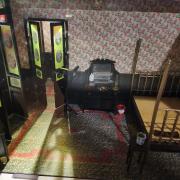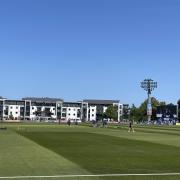
Oscar Wilde’s only full-length novel, ‘A Picture of Dorian Gray’ has enjoyed a stage production in Bromley this month. ‘A Picture of Dorian Gray’ (the novel, not the play that shares its name) received a terrible reception upon its publication. The reviews were dreadful, the sales poor, and it was not until many years after Wilde’s death that this remarkable work of imagination was recognised as a classic. A bit of context before jumping into a review of the performance is necessary to understand how ‘A Picture of Dorian Gray’ is perceived. First commissioned in the summer of 1889 by an American editor for Lippincott’s Monthly Magazine, when published, WHSmith refused to sell the magazine because it contained Wilde's story.At the time its content was seen as extremely shocking, but read today, ‘A Picture of Dorian Gray’ is an entertaining parable of the aesthetic ideal (art for art’s sake), of which Wilde was a follower. So how does Tilted Wig's interpretation fair?
Well from a story-telling perspective, the play is very accurate to the novel. All of the main beats, right from the titular picture’s creation to its destruction at the hands of Dorian are all mapped out rather well, with many lines ripped right from the novel by the Director and Adaptor, Séan Aydon. Some characters and their corresponding arcs have been amalgamated into a single character, without altering the story. When asked about crafting the play, Aydon wrote, “We have attempted with our production to leave room for the audience to explore their own darkest thoughts, fears and desires. This is not a morality tale but a tale that questions the existence of morality”. To summarise the story, a young orphan called Dorian Gray (Gavin Fowler) meets Basil Hallward (Daniel Goode), a renowned artist. Dorian’s presence in Basil’s life boosts his art, and Basil gets Dorian to become his muse, creating a portrait of him. One day when Dorian is sitting for his portrait, Basil’s friend Lord Henry Wotton (Jonathan Wrather) indoctrinates the callow youth to his way of life, he echoes the ideology of aestheticism, and convinces Dorian that the only thing worth having is youth and that there is no such thing as moral or immoral. When Dorian sees Basil’s portrait of him, he fully releases the importance of his beauty and unwittingly sells his soul so that the portrait will grow old, while he will stay eternally youthful. The main events of the story revolve around Dorian’s decline, becoming more and more callous and sinful due to Lord Henry’s influence and having his portrait take on the repercussions of his sins.In terms of stage craft and design, the play uses some really interesting techniques. The stage is just one room with a number of props on it (like a sink, a piano, a gun and a knife, to name a few) and when the characters need to be somewhere else, the lighting changes to reflect this. For example, the characters go from Basil Hallward’s artist studio, where the lights are bright, to the dingey theatre of the East End, where only two lamps illuminate the stage. The designer Sarah Beaton explained, “We felt that the action could exist in one space or ‘container’ which would not only make the space architectural but also psychological. Researching Victorian buildings with their high ceilings and ornate skirtings was appealing but it was the decayed nature of these once opulent and decadent features with peeling walls which we felt spoke of the beauty and decay that runs thematically throughout the text.” All props used were not decorative, but absolutely necessary to the storytelling and it was clear that a lot of thought had been put into prop placement as well as actors' movements to give a fluid sense of their intentions. One of the most important props is the picture itself. Instead of having an actual painting of Dorian, the portrait is a framed piece of glass. This choice of making the portrait glass really plays on perspective. For example, when the portrait is first finished Dorian holds it up to the audience, with his face behind the glass making it look like a portrait, and once it changes due to Dorian’s sinful actions, the glass becomes cracked, creating a distorted vision of Dorian. When the portrait isn’t being held up, its either on an easel facing away from the audience or covered up by Dorian to make sure no one sees the damage his sin has done to the image,upholding the illusion the prop creates.
Costume design is also rather good, it shows the difference between the classes (with Dorian and Lord Henry often wearing tailored suits). Beaton explained, “As the space is neither period specific nor ultra modern, the director and I wanted the costumes to have a similar aesthetic and echo aspects of both. We tried to avoid anything overtly period such as corsets or cravats, but instead opted for clothes which could straddle both periods such as silk neckerchiefs and braces”. In fact, Dorian originally appears in just a shirt and trousers but later begins to wear more tailored suits, whereas Lord Henry originally appears in a suit but finally appears in a messy shirt, trousers and bare-foot, hunched over himself due to the effects of drugs. This smart costume design really accentuates the idea of decadence- moral decline characterised by excessive indulgence in pleasure or luxury. As Dorian becomes more immoral, his fashion sense becomes more expensive and flamboyant.
The performances were spectacular. The advertising was mostly centred around Jonathan Wrather,well known for his appearances in Coronation Street and Emmerdale, as Lord Henry Wotton (his face is on the posters) who gave a very charismatic, yet evil rendition of Dorian’s ‘idol’. Gavin Fowler played the young man’s decline extremely well and was a very frightening figure in many of the scenes later in the play. Goode gave the audience a rather sympathetic, if not a bit naïve, Basil Hallward. Kate Dobson played the tragic character of Sibyl Vane, the actress Dorian “falls in love with” with a wide range of emotion. Dobson’s performance’s emotional impact on the audience is admirable as her character only appears for a very short-time in the play.
The choreography is also commendable. For example, Dorian and Henry go to an ‘eye’s wide shut’ type party. The flashing lights, provocative dancing and strange score highlight the chaos of the party but also the sin of Dorian as the audience are left to assume the debauchery he is involved in. Furthermore, the audience get to witness a horrifying murder on stage, and the movement of the actors in this scene just emphasises the brutality of Dorian and his downfall.
In summary, Tilted Wig’s rendition of Oscar Wilde’s, ‘A Picture of Dorian Gray’ is an enjoyable piece. Being on the A Level English Literature curriculum, 'A Picture of Dorian Gray’ affords the opportunity to reflect on youth, decisions and morality. The show is touring nationwide through Spring. Furthermore, the Churchill Theatre, Bromley, served as a Co-Producer, and is a fantastic venue (offering visitors a range of productions, from leading West End musicals, top comedians, bands, dramas, dance, classical music and opera, as well as their ever-popular annual pantomimes) and will be hosting Tilted Wig’s Autumn tour of ‘Murder, Margaret and Me’. The performance really grasps Wilde’s idea, “Each of us has a heaven and a hell in us”































